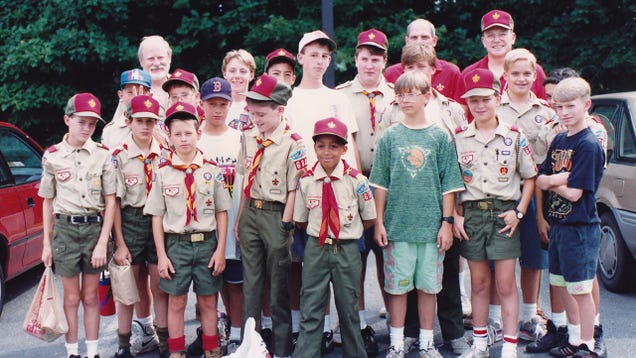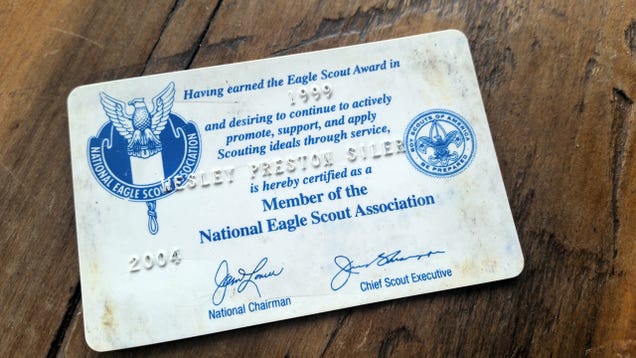
It’s been 15 years since I was a Boy Scout and, by all accounts, I’m now a grown ass man. But, the impact the organization had on my life is still evident in my daily life. Here’s how.
That’s me, turned sideways in the front row above.
Boy Scouts Taught Me To Shoot: Late last November, I had the opportunity to jump in on a last minute hunting trip. I showed up, was handed an unfamiliar rifle, shot three rounds on a range, then headed into the field with six bullets in my pocket. The next morning, I came back with five of those bullets and the pig you see here. I hadn’t even handled a rifle in 10 years or more, but picking up this Weatherby Mark V, I was immediately able to use it with confidence. As the herd of pigs ran across me 50 yards away, at full speed, I was able to pick the fattest sow, line her up and shoot her square in the heart. She was dead before she hit the ground and I took home 75lbs of the nicest tasting, healthiest pork possible.
Who do I have to thank for that? Mr. Switzer, my old Scout Master. A former Army Ranger sniper in Vietnam, he instilled in the troop both a respect for firearms, and the ability to use one. I didn’t have to buy meat for months thanks to Boy Scouts.http://ift.tt/1k96EKP…
Boy Scouts Gave Me Confidence: I know I can handle a gun, shoot an arrow, build a fire, paddle a canoe, build a shelter, use a knife, save a life and about a million other skills. No, I don’t get to show off my sweet whittling skills every day here in Hollywood, but the subconscious memory of those capabilities has a way of putting everyday challenges into perspective.
This weekend, I’m going spearfishing for the first time. Bet I catch something. Every new challenge is now just another small addition to a solid foundation of capability. In the case of spearfishing, all the swimming and fishing and paddling I did as a Scout will help out, but even when it comes to launching a new site around a totally new topic within Gawker, I know I’m up to the task.http://ift.tt/1wAAOxw…
Boy Scouts Gave Me The Ability To Save Lives: Back in college, I was sitting in a pub with my little sister and her friends when I had to pee. When I walked into the bathroom upstairs, an elderly man was rolling around on the ground, in the last throes of choking before passing out. I picked him up, gave him the Heimlich maneuver, then sat with him until he recovered. This being England, you don’t make a fuss out of things, so when we walked back down 30 minutes later, everyone got quite the giggle out of me showing up after a very long bathroom break with a new, red-faced friend thanking me profusely. I didn’t want to embarrass him in front of his family, so didn’t explain things until after they left.
And that’s just one incident. Elsewhere, I’ve pulled people out of the ocean, from wrecked cars, used my motorcycle to stop highway traffic on the 405 to protect a crashed biker and probably a few other incidents I’ve forgotten. That’s not me being a hero, that’s an Eagle Scout doing his job.

Boy Scouts Gave Me The Outdoors: As you’d expect, we spent some time outside as Scouts, doing everything from canoe trips to rock climbing to sailing on the ocean. That experience doing those things and learning to master them has given me the ability to continue to enjoy all that to this day. Whether it was rafting last weekend or going kayak camping/spear fishing tomorrow, an entire world of outdoor recreation is now easily accessible thanks to the skills, confidence and experience Scouts gave me.http://ift.tt/1lS2FaC…
Scouts Taught Me To Survive: Know how everyone thinks they’re a survival expert now that Bear Grylls taught them how to drink their own urine? Survival entertainment is massively misleading and downright dangerous. It’s extraordinarily unrealistic that you’d be able to start a fire with nothing but two sticks and, in most survival scenarios, you wouldn’t need to. The genre has created unrealistic expectations and armed people with false confidence. Know what Scouts taught me? Be Prepared. That approach has served me equally well when weather has taken an unexpected turn for the worse while camping or when needing to self rescue after a dirt bike accident in a remote desert. It’s planning ahead, identifying potential risks, then preparing for them that will save your ass, not eating grubs.

Scouts Made Me A Leader: There’s not much that’s more confidence destroying than being an awkward 13-year old boy like the one pictured above (that’s me). But, even then, when any other kid like me would have just hidden in their shell, Scouts gave me responsibility and the opportunity to lead others, something that gave me a huge amount of confidence at the time and has stuck with me until today. 11 people are tagging along on our trip to Catalina this weekend with total confidence that they’re going to have a great time and be safe, even on the ocean in freakin’ kayaks. All I had to do was suggest the idea. This is a fairly typical scenario, whether it be with colleagues or friends.
Scouts Are The Best Secret Society: Forget the Illuminati or the Skull and Bones. You want to be part of a fraternal order that means something? At 33 years old, I still put "Eagle Scout" on my resume and keep my membership card in that organization behind my driver’s license. It’s gotten me into jobs, out of trouble and immediately marks me out to other members as a peer that can be relied upon. We actually kinda run the world.

Scouts Made Me A Worker: When I’m not cranking out 5 to 10,000 words a day, you’ll find me working out at the gym, taking my dog hiking or fixing up my house. I never stop. It’s not an illness, it’s an appreciation of the value of hard work and a mindset that values long term goals. You won’t find a colleague of mine that wouldn’t immediately describe me as the hardest working guy on the team and I more than pull my weight in any endeavor I embark upon, even if that’s just making sure I’ve got the heaviest pack on a backpacking trip. Guess where I learned that? You got it.
Scouts Made Me Value Difficulty: I have a habit of making things difficult for myself. Some would describe it as self destructive, but I don’t often meet people who aren’t a little jealous of the life I’ve built for myself as a result. Five years ago, I quit what would be many people’s dream job — Jalopnik’s first Road Test Editor — to go full time on a business I’d been building my whole time working there, my very own motorcycle publication. Media is a hard industry right now and motorcycles is an even worse one, but I wasn’t intimidated. I slaved away, had a lot of great experiences, built something that mattered and then decided I wanted to do something else. So, I pitched Gawker on launching a site around adventure travel in the outdoors and here I am today. We just decided to make it a permanent part of the mix here at Gizmodo. Not bad, right? Thanks Scouts.
IndefinitelyWild is a new publication about adventure travel in the outdoors, the vehicles and gear that get us there and the people we meet along the way. Follow us on Facebook, Twitter and Instagram.
via Gizmodo
Boy Scouts Made Me The Man I Am Today, Here’s How